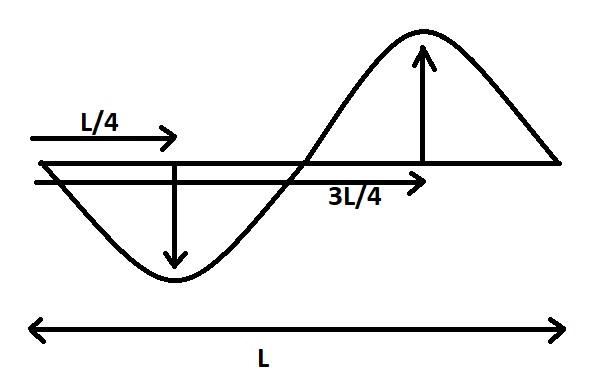
The distance between a node and an anti-node is
A. \[2\lambda \]
B. \[\lambda \]
C. \[\dfrac{\lambda }{2}\]
D. \[\dfrac{\lambda }{4}\]
Answer
576.3k+ views
Hint: From definition we know that an antinode and a node is \[\dfrac{1}{2}\]the distance between \[2\]consecutive nodes. Then we solve it using the formula \[\lambda = 2(2 \times \]Distance between a node and an antinode\[)\].
Complete step by step solution:
Here,
From the definition we know that,
The wavelength of a wave is defined as having twice the distance between two consecutive nodes and antinodes.
Now,
The distance between an antinode and a node is \[\dfrac{1}{2}\] the distance between \[2\] consecutive nodes.
Therefore,
\[\lambda = 2(2 \times \] Distance between a node and an antinode\[)\]
Hence,
The required distance is \[\dfrac{\lambda }{4}\]

Note: From definition we know that an antinode is the place where the wave’s maximum amplitude is generated by positive interference of the incoming and reflected waves. A node, by comparison, is the position where destructive interference reduces the amplitude of the wave to zero.
Complete step by step solution:
Here,
From the definition we know that,
The wavelength of a wave is defined as having twice the distance between two consecutive nodes and antinodes.
Now,
The distance between an antinode and a node is \[\dfrac{1}{2}\] the distance between \[2\] consecutive nodes.
Therefore,
\[\lambda = 2(2 \times \] Distance between a node and an antinode\[)\]
Hence,
The required distance is \[\dfrac{\lambda }{4}\]

Note: From definition we know that an antinode is the place where the wave’s maximum amplitude is generated by positive interference of the incoming and reflected waves. A node, by comparison, is the position where destructive interference reduces the amplitude of the wave to zero.
Recently Updated Pages
Master Class 9 General Knowledge: Engaging Questions & Answers for Success

Master Class 9 English: Engaging Questions & Answers for Success

Master Class 9 Science: Engaging Questions & Answers for Success

Class 9 Question and Answer - Your Ultimate Solutions Guide

Master Class 12 Business Studies: Engaging Questions & Answers for Success

Master Class 12 Economics: Engaging Questions & Answers for Success

Trending doubts
What is meant by exothermic and endothermic reactions class 11 chemistry CBSE

Which animal has three hearts class 11 biology CBSE

10 examples of friction in our daily life

One Metric ton is equal to kg A 10000 B 1000 C 100 class 11 physics CBSE

1 Quintal is equal to a 110 kg b 10 kg c 100kg d 1000 class 11 physics CBSE

Difference Between Prokaryotic Cells and Eukaryotic Cells




